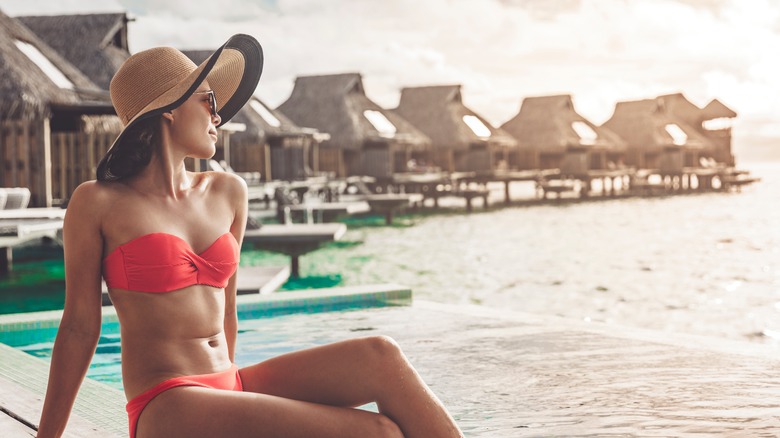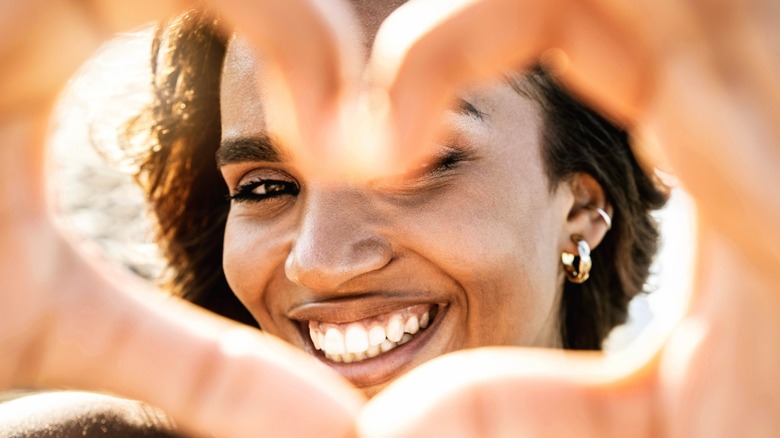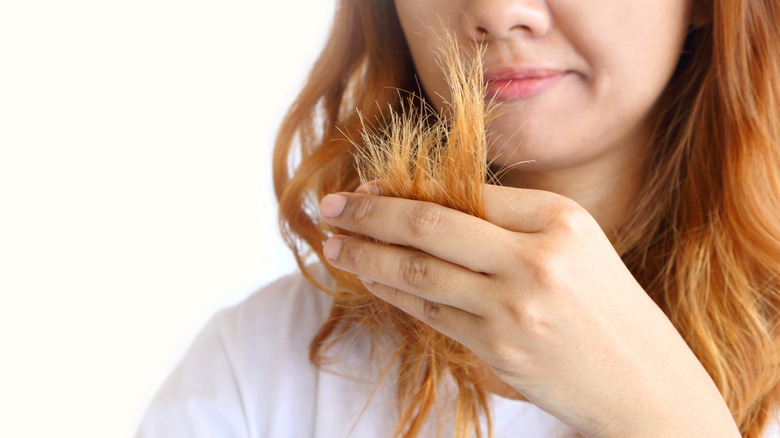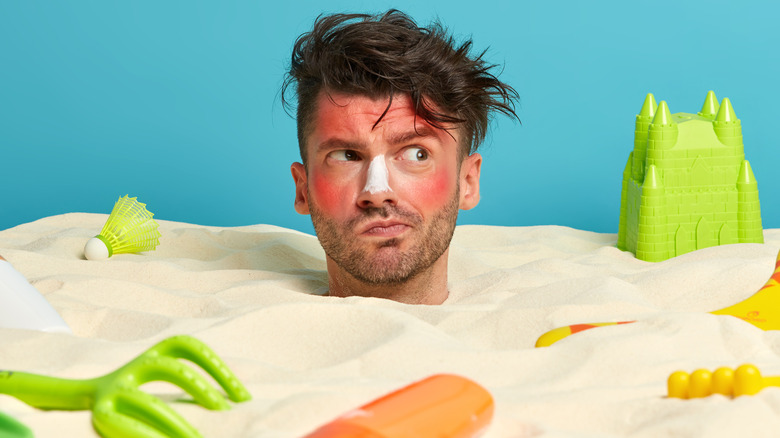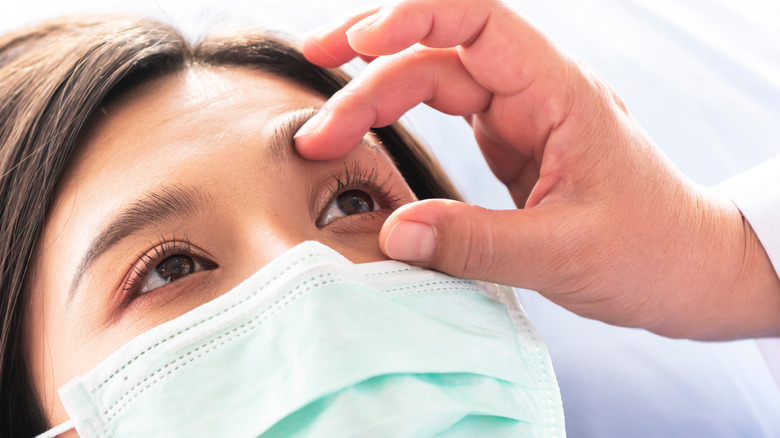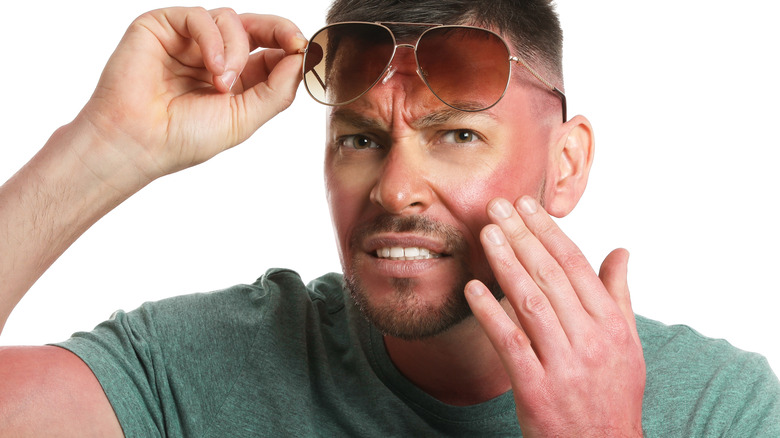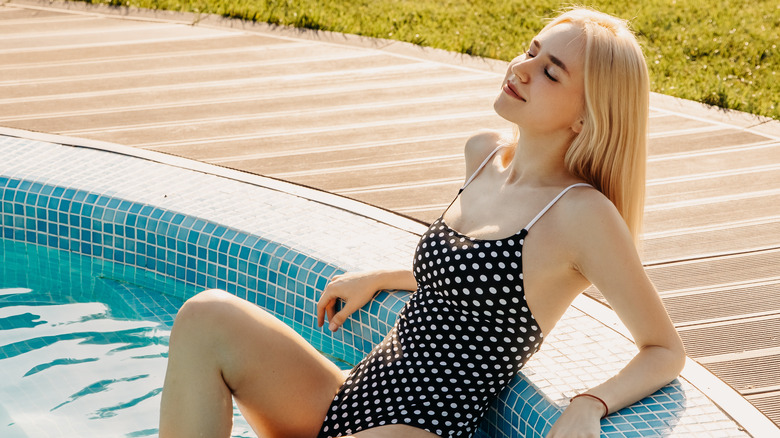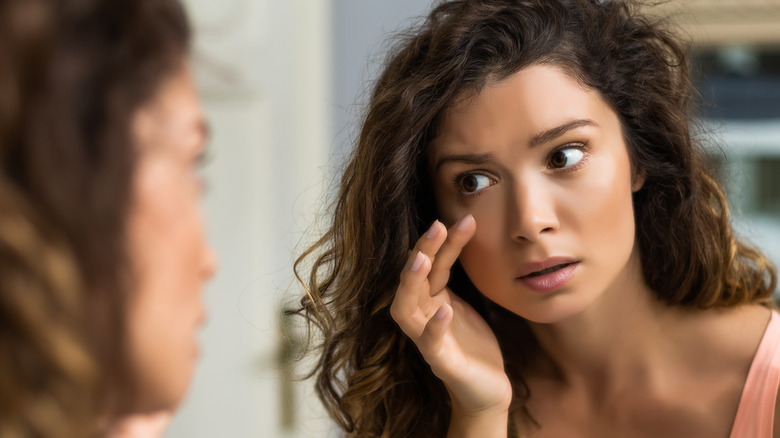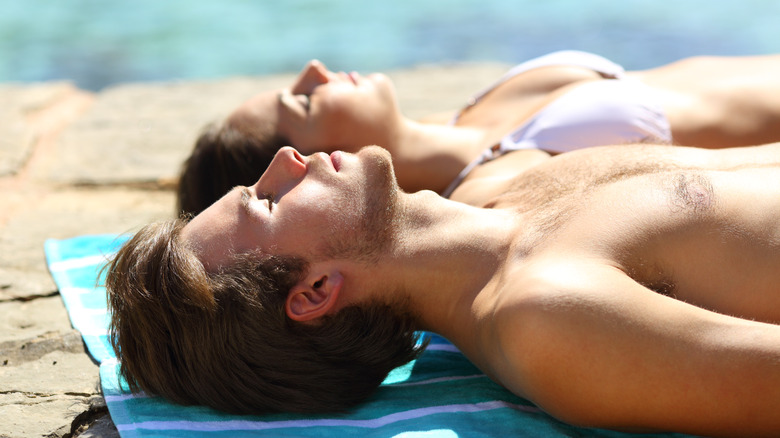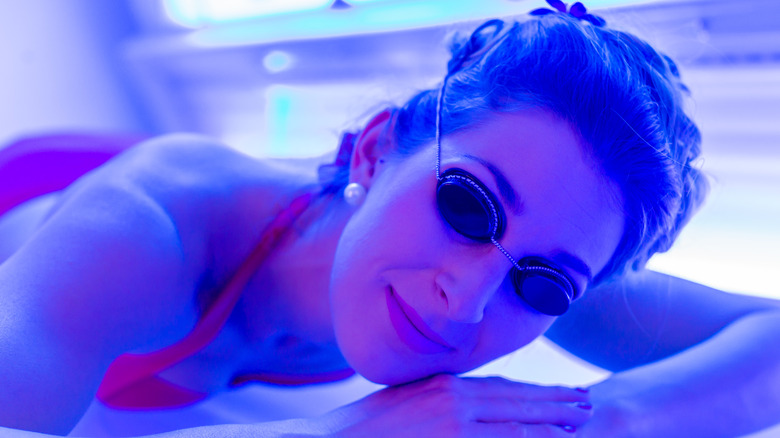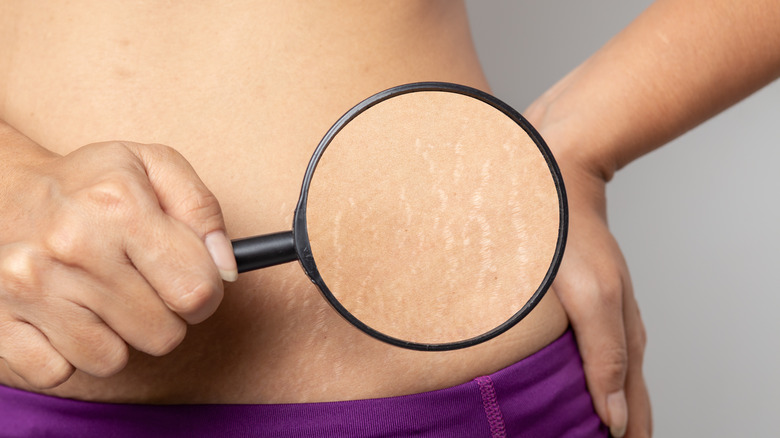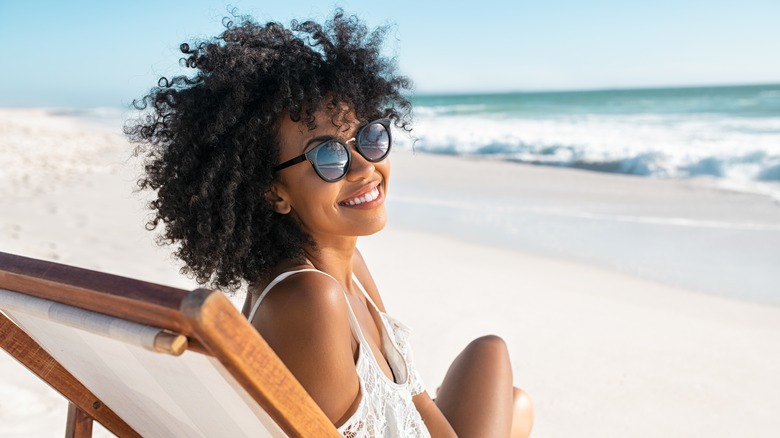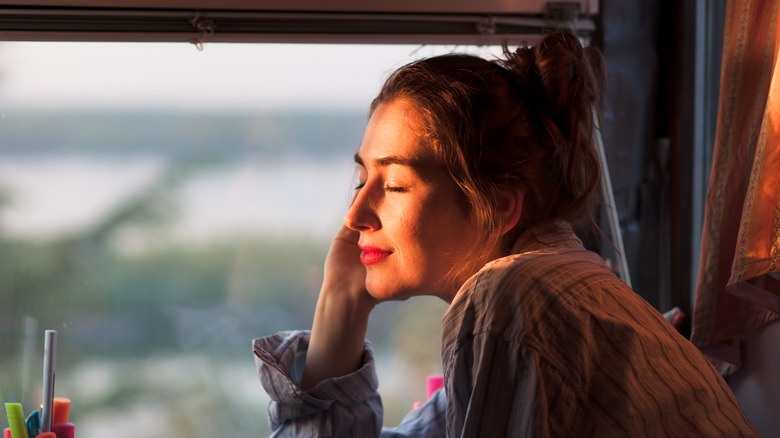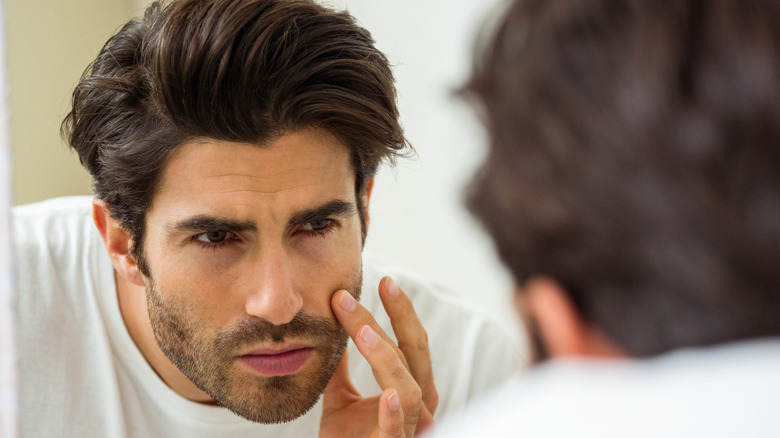What Happens To Your Body When You Go Tanning Every Day
"Throughout history and all over the world, sunlight has been worshiped for its health-giving properties and used as a medicine," notes British researcher and author Richard Hobday (via the New York Times). A toasty glow on our skin makes us look healthier and feel great. Time spent in ultraviolet light, a study in the Journal of the American Heart Association reveals, will even lower your blood pressure. With so many positives, it's no wonder that many of us feel naturally drawn to the sun.
All of this sounds really good, so what's the bad news? Just ask the 9,500 people in the U.S. who are diagnosed with skin cancer every day. While moderate amounts of incidental sun exposure are generally okay, too much of it can have some pretty terrible consequences, warns Johns Hopkins Medicine. "Repeated [sun] exposure will lead to premature aging, [and] thickened and leathery skin," explains London-based consultant dermatologist Dr. Sasha Dhoat to Newsweek. "[It's also] a direct attack on cellular DNA, our genetic blueprint, leading to skin cancers."
What happens to your body when you tan every day? Let's take a look at the good and the bad, and see what the experts have to say.
Sunlight can boost your mood
Sunlight is a known mood lifter. It boosts serotonin levels in the brain. Serotonin is a neurotransmitter; when it's abundant, it acts as a mood stabilizer that makes you feel calm, happy, and focused, explains the Cleveland Clinic. Some people even call it the body's "feel-good" chemical. And basking in UV light while tanning certainly activates it. "The sun works through a number of receptors in the brain to affect our mental status and alertness," confirms Dr. Michael Roizen, chief wellness officer at the Cleveland Clinic (via Forbes).
When your body is low on serotonin, you may suffer from depression, or seasonal affective disorder (SAD). However, the sun's ultraviolet rays are just one way of normalizing serotonin levels in your body. Diet, exercise, and some supplements can also help, per Healthline.
"Humans have a lot of beneficial biological processes that occur as a direct result of sun exposure," explains Dr. Michael Holick, director of the heliotherapy, light, and skin research center at Boston University Medical Center (via Self). "You might see a few of those with vitamin D supplementation, but not to the degree that you do with simply being out in the sun."
Your hair color may change
Sun, saltwater, and melanin work together to achieve sun-kissed tresses. But whether your natural hair color is blonde, brunette, or auburn, the sun is bound to fade the color — and the resulting shade might not be totally welcomed, as it can turn an overly warm brassy color that looks too yellow on blondes, or orange-tinged on a brunette or redhead.
The more time you spend in sunlight, the more your hair color fades and gets lighter. "Sun bleaches out the melanin in hair, which is what causes it to become lighter," explains dermatologist Dr. Annie Gonzalez of Riverchase Dermatology in Miami, Florida (via Healthline).
While a hair stylist can restore the color, too much sun-worshipping will take a toll on your tresses over time. It not only messes with the color, but also dries out the ends. "UV rays can make hair brittle and appear frayed," says New York City dermatologist Dr. Kavita Mariwalla (via Allure). "Sunlight is drying and can lighten hair simply from exposure, [and] your scalp, like any other skin on the body, is susceptible to skin cancer."
You'll age more quickly
A healthy-looking tan can sure make you look good, but the truth is that too much time working on your tan ends up aging you beyond your years. We're constantly exposed to sunlight, but over time, ultraviolet rays cause structural damage to the skin, and the effect is cumulative. It's called photoaging, and it's the main reason we get fine lines, wrinkles, uneven skin tone, and textural changes that become really annoying (and expensive to fix) in middle age or earlier, according to Verywell Health.
"It's a myth that people with dark skin tones are immune to the harmful effects of UV radiation," states the Columbia University Irving Medical Center. While lighter skin is especially susceptible to photoaging and skin cancer, every skin type is at risk for sun damage.
"I see many patients who have a lot of sun damage," says Dr. Kathleen Suozzi, assistant professor of dermatology at Yale School of Medicine. "They feel like their skin aged them, that they appear older than some of their peers, and they're regretful of not being better with sun protection in their youth."
You could damage your eyes
Sunglasses aren't just for fashion. If you spend a lot of time getting your tan on, then wearing good quality eye protection is just as important as slathering on sunscreen. Why? It's simple: You can actually sunburn your eyes.
Overexposure to ultraviolet light may cause a condition called photokeratitis, which is an inflammation of the clear covering of the front of the eye, or the cornea. When you have sunburned eyes, they'll feel gritty, painful, and swollen, and you may also experience temporary blurred vision, according to Healthline. With repeated exposure to too much sun on unprotected eyes, you could eventually develop cataracts or even eye cancer.
"Unfortunately, many people are unaware of the dangers UV light can pose," explains ophthalmologist Dr. Michael Kutryb, a spokesperson for the American Academy of Ophthalmology. "By wearing UV-blocking sunglasses, you can enjoy the summer safely while lowering your risk for potentially blinding eye diseases and tumors."
Skin tone matters, but cancer can still strike
It's a myth that if you have darker skin, you don't need to worry about skin cancer. Melanin-rich skin forms a natural barrier to some of the sun's damaging rays, but it doesn't block out everything. "Darker-skinned people can still develop skin cancer and experience photoaging," explains Dr. Elizabeth Bahar Houshmand, a dermatologist in Dallas, Texas (via Healthline). "A tan, in all skin colors, indicates damage to your skin and the damage leads to skin cancer and aging."
In fact, a 2016 study published in the Asian Pacific Journal of Cancer Prevention demonstrated that when people of color are diagnosed with skin cancer, it's often already at a more advanced stage because it's harder to detect. This leads to worse outcomes. So if you have a deeper complexion and spend regular time in the sun, don't skip protection. "A sunburn in brown skin usually presents as peeling and tender skin after sun exposure, which means that DNA damage is still happening," says dermatologist Dr. Purvisha Patel to Essence magazine.
Too much sun makes dark spots even darker
Patches of your skin that are already darkened (or hyperpigmented) from things like freckles, age spots, or melasma, will be even more noticeable if you spend a lot of time outdoors or on a tanning bed, says the American Osteopathic College of Dermatology. Just like the way the rest of your skin tans, those darker areas also get a deeper layer of color and look more pronounced with zealous UV exposure. The areas that tend to get the most sun — and overexposure — are your head, face, neck, hands, and arms, per the Centers for Disease Control and Prevention.
"While freckles do not represent an underlying disease and can get darker even with small amounts of UV light exposure, it's important to notice if your freckles are getting darker," says dermatologist Dr. Joshua Zeichner, director of cosmetic and clinical research in dermatology at Mount Sinai Hospital in New York City (via Byrdie). "This tells you that you're getting a good amount of sun exposure and should remind you to wear your sunscreen."
Getting a base tan doesn't prevent skin damage
At first, it may seem to make sense to get a bit of a starter tan before heading out on vacation. However, there's little evidence to support the practice, according to Dr. Peter Katz, a Wisconsin-based dermatologist with Forefront Dermatology. "In fact, even a relatively deep 'base tan' only equates to about an SPF of 2 or 3."
According to Healthline, if you're determined to sunbathe, you should wear at least an SPF 30 sunscreen, limit your time outside to just short late afternoon or early morning tanning periods and seek shade regularly so you don't overdo it. But why subject yourself to the risks of skin cancer, sags, and wrinkles, when you can achieve the perfect sunkissed glow from a bottle?
"I often hear from patients who are fair-skinned that they want a little more color," says Kaiser Permanente's chief of dermatology Dr. Jeff Benabio. "I tell them that using sunless tanning products can help them get a tan without spending time in the sun."
Tanning may suppress your immune system
Among the many good things that some sunshine-time can achieve, going overboard is never a good plan. One big reason is skin cancer. "Too much [UV] exposure suppresses the ability of the human immune system to efficiently detect and attack malignant cells," warns Daniel González Maglio, a professor at the University of Buenos Aires and photoimmunology researcher (via the New York Times).
Likewise, indoor tanning is a no-no. Its effects can actually be far worse in every way because of concentrated exposure to ultraviolet light, confirms the Skin Cancer Foundation. "Frequent [indoor] tanners using high-pressure sunlamps may receive as much as 12 times the annual UVA [ultraviolet A] dose compared to the dose they receive from sun exposure." Those ultraviolet A rays reach deep down into the skin layers and cause genetic damage to cells.
Indoors or outdoors, the World Health Organization confirms that regardless of skin color, too much UV radiation can alter immune system function and the skin's natural defenses. This immune system suppression may make your skin more sensitive to sunlight, or may even make the vaccines you receive less effective.
You could actually become a tanning addict
For some people, tanning triggers the brain's reward center in a powerful way. Just as someone can be addicted to gambling or drugs, they can also be addicted to tanning. "Once the rewarding feeling pushes the behavior from a habit to a required action, you will begin to make the action your top priority," explains GoodRX Health. "Other people and activities take a back seat to addiction."
Research published in the Journal of the European Academy of Dermatology and Venereology showed that people with tanning disorders were "six times as likely to also be dependent on alcohol," per the Yale School of Public Health. Mental health issues such as seasonal affective disorder (SAD), depression, anxiety, and body dysmorphic disorder have also been linked to tanning addiction.
"The biological rationale for tanning dependence is that exposure to UV light results not only in melanin production but also the production of endorphins," San Francisco-based psychodermatologist Dr. Josie Howard told Allure. "This means that we may go back to that activity, again and again, to get that endorphin hit."
Indoor tanning is not any safer
All the risk and none of the gain is what you can expect from indoor tanning. And if you're hitting up tanning beds on a regular basis, you're really playing with fire.
How can this be? The longer wavelength of UVA rays — the primary type you receive with indoor tanning — get deeper into the skin layers and are "strongly linked to melanoma," confirms the Skin Cancer Foundation. There's also more potential for eye damage because indoor tanning produces UV levels up to 100 times stronger than those from the sun, says the American Academy of Ophthalmology. Lastly, you don't even get any vitamin D benefits because the main source for producing it in the skin is UVB, not UVA rays (per the Skin Cancer Foundation). So from literally every angle, tanning beds are a lose-lose proposition.
"Tanning beds are just as, if not more, harmful than the sun and there is no such thing as a safe tan," says dermatologist Dr. Jennifer Lucas of the Cleveland Clinic. "There [are] many reasons to avoid tanning beds altogether."
If you have stretch marks (or other scars), they'll be more visible
Stretch marks, and scars of any kind, don't tan. In fact, spending a lot of time in the sun trying to tan them away may actually produce the opposite effect by making them stand out even more. If you want added color on your skin, then an artificial tan is a vastly better (and safer) option, according to the American Academy of Dermatology. "While tanning can make stretch marks more noticeable, a self-tanner can camouflage stretch marks — both early and mature ones."
The silvery-white streaks from stretch marks are the result of rapid stretching. It causes the skin's elastin and collagen to break and form a type of scar, explains the Cleveland Clinic. These scars may fade over time, but will never completely go away. Attempting to camouflage your stretch marks or other scars with a suntan is never a good idea, since you're just adding to the risks of skin cancer. Worse, you'll just end up darkening the edges of the scar.
But sun exposure may help some health conditions
Ultraviolet rays are not entirely bad for us. Besides being great for a mood boost, UV light can also clear up some skin disorders, such as eczema, psoriasis, and vitiligo, according to WebMD, and calm down the overreactive immune systems that are causing those conditions (via UVA Health). When UV rays are administered in a controlled environment, it's called phototherapy. It's a specialized treatment, performed under a doctor's supervision, that simulates the effects of sunlight in regular, short sessions.
A number of targeted treatments have been shown to be effective in reducing psoriasis flares, including phototherapy. The chronic autoimmune skin disease, described by the CDC as thick and scaly red or silvery patches on the body, has been greatly helped by doctor-prescribed UV light therapy, per the Mayo Clinic.
"We use ultraviolet light from artificial sources to trigger biologic processes that reduce inflammation and prevent skin cells from growing too quickly," according to Cedars-Sinai in Los Angeles. "Regularly exposing the affected area to this type of light controls inflammation and helps clear the skin."
You'll get plenty of vitamin D, but don't overdo it
Vitamin D builds strong bones, supports your immune system, and also muscle and brain functions, says the Mayo Clinic. Most of what you need for adequate vitamin D you can get through food or by taking a supplement. The sun also plays a role, but contrary to what many people think, you don't need to become a sun worshipper to get an adequate dose.
The World Health Organization says it only takes five to 15 minutes of incidental sun exposure on your hands, face, and arms for optimal benefits from sunshine. If you're thinking a tanning bed might be ideal for getting your daily dose, think again. Indoor tanning is not only dangerous, but also useless for vitamin D, because tanning beds emit primarily UVA rays, but it's UVB that's needed to make vitamin D (per the Skin Cancer Foundation).
"The vitamin D found in our body needs activation. The sun helps to convert inactive vitamin D levels to active," explains Dr. Michael Roizen, chief wellness officer at the Cleveland Clinic (via Forbes). But should you wear sunscreen? Absolutely! Even if you wear SPF 30 protection, it's not total sunblock, as it filters out only 97 percent of the UV rays (if used exactly as directed). So your skin is always getting some UVB rays, which is the wavelength that triggers vitamin D production, the Skin Cancer Foundation confirms.
If you have acne, you'll make it worse
Sure, it's true that having a tan can help camouflage acne on your face or body, but it's really not the best way to attack the issue. So don't make baking at the beach part of your game plan. Better options exist that don't beat up your skin with ultraviolet rays that will ultimately create even more problems down the road.
"UV rays are lethal to P. Acnes [propionibacterium acnes], the main bacteria that contribute to acne, but they also injure the skin, causing brown spots, wrinkles, and sagging," confirms dermatologist Dr. Ava Shamban (via InStyle). "So, you trade one problem for another longer-lasting one."
A much better solution for toning down acne is to get it under control with good skincare and treatments first. Then for some added color, apply a sunless tanner. It'll help neutralize the red and you'll get all the benefits of a natural tan but do it in a healthier, non-damaging way. "In acne-prone patients," advises New York City dermatologist Dr. Jeremy Brauer (via Allure), "it is important to always look for non-comedogenic products that reduce the risk of clogged pores and acne breakouts."

